Ravidassia
| Part of a series on the |
| Ravidassia |
|---|
 |
| Beliefs and practices |
| Temples |
| Scriptures |
| Amritbani Guru Ravidass Ji, Guru Granth Sahib |
| Holy Places |
| Founder |
| Sants |
| Festivals |
| Symbols |
| ਹਰਿ |
Ravidassia or the Ravidas Panth[1] is an Indian religion based on the teachings of Ravidass, who is revered as a satguru.[2][3][4]
Historically, Ravidassia represented a range of beliefs in the Indian subcontinent, with some devotees of Ravidass counting themselves as Ravidassia, but first formed in the early 20th-century in colonial British India.[3] The Ravidassia tradition began to take on more cohesion following 1947, and the establishment of successful Ravidassia tradition in the diaspora.[5] Estimates range between two to five million for the total number of Ravidassias.[6][7]
Ravidassias believe that Ravidas is their Guru (saint) whereas the Sikhs have traditionally considered him one of many bhagats (holy person), a lower position to Guru in Sikhism.[8] Further, Ravidassias accept living sants of Ravidass Deras as Guru[9] A new Ravidassia religion was launched following an assassination attack on their visiting living Guru Niranjan Dass and his deputy Ramanand Dass in 2009 in Vienna by Sikh militants.[1][10] Ramanand Dass died from the attack, Niranjan Dass survived his injuries, while over a dozen attendees at the temple were also injured.[10] This triggered a decisive break of the Ravidassia group from the orthodox Sikh structure.[9][1]
Prior to their break from Sikhism, the Dera Bhallan revered and recited the Guru Granth Sahib of Sikhism in Dera Bhallan.[11] However, following their split from mainstream Sikhism, the Dera Bhallan compiled their own holy book based exclusively on Ravidas's teachings, the Amritbani Guru Ravidass Ji, and these Dera Bhallan Ravidassia temples now use this book in place of the Guru Granth Sahib.[11][4][12]
Basis

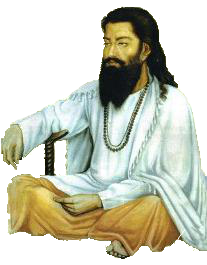
Ravidas was born on 15 January 1377 CE (Indian calendar Sunday Sukhal Falgin Parvithta 1433) to the Chamar community.[13] [14] His birthplace was a locality known as Seer Govardhan in the city of Varanasi, Uttar Pradesh state, India. The birthplace is now marked by the Shri Guru Ravidass Janam Asthan (Begampura), and is a major place of pilgrimage for the followers of Guru Ravidas today. Ravidassias believe that Ravidas died in Benares at the age of 151.[15][16][17]
Beliefs
Ravidas taught the following principles:[citation needed]
- The oneness, omnipresence and omnipotence of God.
- मन चंगा तो कठौती में गंगा.
- The human soul is a particle of God.
- The rejection of the notion that God cannot be met by lower castes.
- To realize God, which is the goal of human life, man should concentrate on God during all rituals of life.
- The only way of meeting with God (moksha) is to free the mind from duality.
Places of worship

A Ravidassia place of worship is called a dera, sabha, mandir, gurudwara, or bhawan, sometimes translated as temple.[18][19] It is considered respectful towards Guru Ravidas and generally mandatory to cover one's head and take off one's shoes when entering the place of worship.
Outside the sabha there is always a flag upon which is written the Nishaan, and above it the "Harr" symbol which symbolising enlightenment from Guru Ravidas' teachings. But Guru Ravidass Sabhas Derby, Walsall, Gravesend, Montreal and Papakura are exceptions, as these Sabhas' official title boards display Ek Onkar and Khanda emblems alongside Harr. The title boards of these sabhas clearly mark the buildings as both Sikh Gurdwaras and Ravidass Temples.[20] Moreover, Derby Sabha's display board mentions it as a Sikh temple[21]
Langar takes place inside the sabha continuously as a practice, and all are free to partake of it.
Scriptures
Ravidassia places of worship contain the holy book Amritbani Guru Ravidass Ji which contains all the hymns by Guru Ravidas. This book contains the following hymns: Raga – Siri (1), Gauri (5), Asa (6), Gujari (1), Sorath (7), Dhanasari (3), Jaitsari (1), Suhi (3), Bilaval (2), Gaund (2), Ramkali (1), Maru (2), Kedara (1), Bhairau (1), Basant (1), and Malhar (3). The book contains 140 shabads, 40 pade, and 231 salok.[22] There are 177 pages in all of the book.
A version of the holy book Amrit Bani containing 240 hymns of Guru Ravidas was installed at the Guru Ravidas temple in Jalandhar, Punjab, on 1 February 2012 on the occasion of birth anniversary of Guru Ravidass. The Dera Sach Khand Ballan religious community had announced the formation of the new Ravidassia religion and separation from Sikhism at Varanasi. The split from Sikhism was triggered after the killing of its deputy head Ramanand Dass in May 2009 at a temple in Vienna by some Sikh radicals.
President of newly formed Begumpura Lok Party and a supporter of the new religion, Satish Bharti, said that the copies of the new Bani were put on display during the religious processions in order to assert that the community members are firm believers of the new religion.[23][24]
Ravidassia in the UK Census
In Britain, during the 2011 Census, the Office for National Statistics counted Ravidassia as a separate religion from Sikhism. There were 11058 individuals[25][26] who claimed themselves Ravidassia in the census, out of around 100,000 strongholds in the Ravidassia community. Data shows that around 10% of members of Ravidassias community cited their religion as ’Ravidassia’ – empathically distinct from Sikhs and Hindus. During the census, not even a single Guru Ravidass Gurdwara came into direct support of this separate identity, and till date, all Guru Ravidass Gurdwaras in Britain are practising Sikhism and they do pray and perform all rituals in the presence of Shri Guru Granth Sahib.[20]
Contrary to Britain’s Office for National Statistics, the Indian government and its census department have not accepted the Ravidassias community as a religion. During the 2011 census, the Ravidassia community was counted alongside other synonymous such as Ramdasia Sikh and Jatav under the title of chamar caste.[27][28]
Customs
The Ravidassia employ the greeting "ਜੈ ਗੁਰੂਦੇਵ" (Jai Gurdev, जय गुरुदेव), meaning “hail the god-like teacher”, the motto of the religion.[29]
Symbols
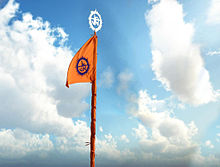
The Ravidassia religious symbol is known as the Harr Nishaan ("sign of God"). The Gurmukhi transliteration of the name Harr is the main symbol of the Ravidassia religion.[11] It is also called as Koumi Nishan.[30]
The religion is also represented by a flag, with the insignia "Har" which, states Ronki Ram, includes:[30]
- A bigger circle with 40 rays of sunlight signifying forty hymns of Guru Ravidas;
- Inside the big circle is a small circle, inside which is written "Har" in Gurmukhi language (ਹਰਿ) with a flame on top of it;
- The flame represents the Naam (word) that would illuminate the entire world, and reaches the outer circle;
- Between the two circles is written a couplet composed by Ravidas: ਨਾਮ ਤੇਰੇ ਕਿ ਜੋਤੀ ਲਗਾਈ, ਭੇਈਓ ਓ ਭਵਣ ਸਗਲਈ (Naam tere kee jot lagayi, Bhaio Ujiaaro Bhawan saglaare, "Your Name is the flame I light; it has illuminated the entire world")
The insignia Har, states Ram, represents the "very being of Ravidass and his teachings".[30] It is chosen after the name of their Guru, as ravi means "illumination" and dass "servant of god".[citation needed]
Sikh Ravidassia

Majority of Ravidasias practicing Sikhism and having faith in Shri Guru Granth Sahib.This sect of Ravidasias are mainly residing in Malwa region of Punjab. Most of the Guru Ravidass Gurdwaras are staunch follower of Shri Guru Granth Sahib and first and oldest shrine on Fiji Island constructed by Ravidassia community is also known as Nasinu Sikh Temple. This Gurdwara was constructed by Ravidasias migrants from Doaba in 1939.[31]
Ravidassia/ Ramdasia and Ad-Dharmi Sects of Punjabi Chamar Community
"Ramdasia is a term used in general for Sikhs whose ancestors belonged ex untouchables Chamar caste. Originally they are followers of Guru Ravidass ji who belongs to Chamar community ".[32] Both the words Ramdasia and Ravidasia are also used inter changeably while these also have regional context. In Puadh and Malwa, largely Ramdasia in used while Ravidasia is predominantly used in Doaba.[33]
Ramdasia Sikhs are enlisted as scheduled caste by Department of Social justice, Empowerment and Minorities- Government of Punjab. On Department's list of Scheduled Caste, this caste is listed on serial number 9 along with other Chamar caste synonymous such as Ravidasia, Jatav and so on.[34]
Ad-Dharmis of Chamar sect are followers of Guru Ravidas ,[35] and incorporate elements of Sikhism[36] as they regard Shri Guru Granth Sahib as their religious text.[37]
Festival
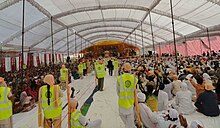
The birthday of Ravidas is celebrated every year at the Seer Gowardhanpur village temple in Varanasi the state of Uttar Pradesh in January or February and the government of India has declared it a gazetted holiday.[38]
Every year more than 1 million devotees from India and abroad visit the Seer Goverdhanpur temple. In India, devotees pour in from Punjab, Haryana, Gujarat, MP, Bihar, UP and Uttarakhand while foreign devotees from the US, Canada and UK throng the village.
On the day there is a Path of Amritbani Guru Ravidas read, the Harr Nishaan Sahib is changed ceremonially, and there is a special Ravidassia Arti and a Nagar Kirtan procession bearing Shri Guru Ravidas' portrait to the accompaniment of music through the streets of the temple locality.
Special pilgrim trains have been run to and from Varanasi for the last 12 years on the occasion of Parkash Ustav of Guru Ravi Dass. A special train has been run from Jalandhar to Varanasi and back every year on Guru Ravidass Jyanti Purb for the convenience of the pilgrims, since 2000.
Ravidasia Diaspora
Ravidasia Sikh diaspora emigrated from India and Pakistan is significant. There are Ravidasia Sikh settlers in Europe, as well as a sizable Ravidasia Sikh population in North America, primarily in the United States and Canada. Mahiya Ram Mehmi and Mahey were the very first people who landed in British Columbia in 1906.[39] They were both also involved in the foundation of the first Canadian Gurdwara, the Khalsa Diwan Society , Vancouver. There is a sizeable population of Ravidasia Sikhs in Oceania too. Ravidassias from Doaba established the second gurdwara in the Oceania region in Nasinu on Fiji Island in 1939.[40] A Classical Study by W.H. Briggs in his book Punjabis in New Zealand, Briggs penned down the precise number of Ravidassias in New Zealand during the very first wave of immigration.[41] Today they have presence in every major city of world where they have also established Guru Ravidass Gurdwaras and Sikh Temples.
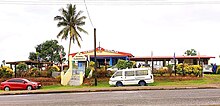

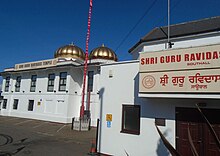

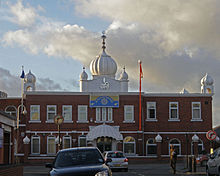


Notable Ravidassia
Religious figures
- Guru Ravidas, was an Indian mystic poet-saint of the bhakti movement during the 15th to 16th century CE
- Giani Ditt Singh - Co Founder - Singh Sabha Movement , First professor of Punjabi Language.[42]
- Bhai Sangat Singh, was a Sikh warrior and martyred of Battle of Chamkaur.
- Haralayya, 11th century Lingayat saint.[43]
- Swami Achootanand, was a poet, critic, dramatist, historian, social reformer, former Arya Samajist and founder of the Adi Hindu movement.[44]
Historical figures
- Avantivarman, was a king who founded the Utpala dynasty. He ruled Kashmir from 855 to 883 CE and built the Avantiswami Temple.[45]
- Sankaravarman, was a Chamar king of the Utpala dynasty,a Hindu kingdom which ruled over the Kashmir region from 8th to 10th century CE.[45]
- Sugandha, was the Queen of Kashmir in the northern Indian subcontinent during the 10th century.[45]
- Didda, also known as The Catherine of Kashmir and The Witch Queen, was the ruler of Kashmir from 980 CE to 1003 CE.[45]
Revolutionaries and freedom fighters
- Banke Chamar, Freedom Fighter.
- Chetram Jatav, Freedom Fighter.
- Captain Mohan Lal Kureel, officer of Chamar Regiment.
- Babu Mangu Ram, known popularly as Babu Mangu Ram Chaudhry, was an Indian freedom fighter, a politician from Punjab and one of the founder members of the Ghadar Party.
Politics
India
- Babu Jagjivan Ram - Former Deputy Prime Minister of India.[46]
- Kanshi Ram - Founder Bahujan Samaj Party and tallest Dalit Leader after Dr. B.R. Ambedkar[47]
- Late Chand Ram (politician)- Former Member Parliament and Former Deputy Chief Minister of Haryana
- Selja Kumari- Former Minister of Social Justice and Empowerment and Tourism in the Government of India.
- Meira Kumar- Former Indian Diplomat and Speaker of Lok Sabha (2004 to 2009).
- Vijay Sampla- Former Minister of State for Social Justice and Empowerment in the Government of India
- Som Parkash Kainth IAS - Former Bureaucrat and Current Union Minister of State for Commerce and Industry, Government of India.
- Rattan Lal Kataria- Union Cabinet Minister, Government of India
- Chaudhary Sadhu Ram (January 1909 – August 1975) - Five-time Member of Parliament from Phillaur Constituency
- Chaudhary Sunder Singh- Member Parliament 1980 - 1989 from Phillaur Constituency
- Bhagat Ram - Former Member Parliament Phillaur Constituency
- Harbhajan Lakha - Former Member Parliament from Phillaur Lok Sabha constituency
- Satnam Singh Kainth - Former Member Parliament from Phillaur Constituency
- Sukhdev Singh Libra - Former Member Parliament Lok Sabha from Fatehgarh sahib Constituency
- Harchand Singh- Former Member Parliament Lok Sabha
- Santokh Singh Chaudhary- Current Member Parliament from Jalandhar Constituency
- Amar Singh (Punjab politician)-Former Bureaucrat and Current Member Parliament from Fatehgarh Sahib.
- Navneet Kaur Rana- Former Actress and Current Member Parliament from Amravati Lok Sabha constituency[48]
- Santosh Chowdhary - Former Member Parliament Lok Sabha
- Shamsher Singh Dullo- Former Member Parliament Rajya Sabha and Lok Sabha
- Harinder Singh Khalsa - Member Parliament and former I.F.S.
- Mohinder Singh Kaypee - Former Member Parliament.
- P. L. Punia IAS - Former Bureaucrat and Former Member Parliament both Rajya Sabha and Lok Sabha
- Sadhu Singh- Former Member of parliament from Faridkot from 2014 to 2019
Governors
- Babu Parmanand - Former Governor of Haryana
- Baby Rani Maurya- Former Governor of Uttarakhand and current Cabinet Minister in Uttar Pradesh Government
Punjab State Politics
- Charanjit Singh Channi- Former Chief Minister of Punjab.[49]
- Lal Chand Kataruchakk - Current Minister for Food, Civil Supplies & Consumer Affairs Forest and Wild Life Preservation, Punjab Government
- Harpal Singh Cheema - Current Finance Minister, Punjab Government
- Dr.Baljit Kaur - Current Minister for Social Justice, Empowerment & Minorities Social Security and Development of Women and Children
- Late Gopal Singh Khalsa - Member of Legislative Assembly during British Rule, Secretary SGPC and first Dalit Sikh who did Law graduation from San Joaquin Delta College, Stockton (California) in 1923.
- Late Master Gurbanta Singh - Tallest Dalit leader of Punjab, educator and key person of Ad Dharm movement.
- Late Chaudhary Jagjit Singh- former MLA of Kartarpur and minister.
- Late Jagat Ram Soondh - Former Cabinet Minister, Punjab Government
- Chaudhary Surinder Singh- Former M.L.A from Kartarpur Assembly constituency
- Avinash Chander - Former 2 times M.L.A
- Pawan Kumar Tinu - Former 2 times M.L.A
- Des Raj Dhugga - Former 2 times M.L.A
- Joginder Pal - Former M.L.A Bhoa Assembly constituency
- Sarwan Singh Phillaur - Former Minister and 6 times M.L.A
- Darshan Singh Kaypee - Former Minister Punjab Government
- Baldev Singh Khaira - Former M.L.A
- Vaninder Kaur Loomba- Former M.L.A
- Jagtar Singh Jagga Hissowal- Former M.L.A
- Kulwant Singh (politician) - First Mayor of Mohali City and Current M.L.A.
- Jiwan Singh Sangowal - M.L.A Gill Assembly constituency
- Saravjit Kaur Manuke - M.L.A Jagraon Assembly constituency
- Sheetal Angural - M.L.A Jalandhar West Assembly constituency
- Dr.Ravjot Singh- M.L.A Sham Chaurasi Assembly constituency
- Dr.Raj Kumar Chabbewal- M.L.A Chabbewal Assembly constituency
- Dr.Sukhwinder Kumar - M.L.A Banga Assembly constituency
- Dr. Charanjit Singh - M.L.A Chamkaur Sahib Assembly constituency
- Rupinder Singh - M.L.A Bassi Pathana Assembly constituency
- Manwinder Singh- M.L.A Payal Assembly constituency
- Hakam Singh Thekedar - M.L.A Raikot Assembly constituency
- Rajneesh Dahiya- M.L.A Firozpur Rural Assembly constituency
- Amandeep Singh Musafir - M.L.A Balluana Assembly constituency
- Amit Rattan- M.L.A Bathinda Rural Assembly constituency
- Principal Budh Ram Singh- M.L.A Budhalada Assembly constituency
- Kulwant Singh Pandori- M.L.A Mehal Kalan Assembly constituency
- Gurdev Singh Mann - M.L.A Nabha Assembly constituency
Other States Politics
- Chandrashekhar Azad, is an Indian lawyer and Dalit rights activist and an Ambedkarite who is the co-founder and national president of the Bhim Army.[50]
- Geeta Bhukkal - Former Minister, Haryana and Current M.L.A since 2005
Others
- Miss Pooja - Punjabi Singer
- Amar Arshi- Punjabi Singh famous for song kala chashma
- Amar Singh Chamkila - Punjabi Singer
- Seth Kishan Dass - was a leather trader, propagator of the Ad-Dharm movement, and a politician.
- Netan Sansara - British Footballer.
Civil servant
- Swaran Ram Darapuri IPS - Former I.G , Uttar Pradesh
- Darbara Singh Guru IAS - Former principal secretary
- P. L. Punia IAS - Former Bureaucrat and Former Member Parliament both Rajya Sabha and Lok Sabha
- Som Parkash Kainth IAS - Former Bureaucrat and Current Union Minister of State for Commerce and Industry, Government of India.
- Amar Singh (Punjab politician) IAS - Former Bureaucrat and Current Member Parliament
- Meira Kumar IFS- Former Indian Diplomat and Speaker of Lok Sabha (2004 to 2009)
See also
- Dera Sach Khand
- Sant Mat
- List of Ravidassia people
- Bhakti movement
- Ramdasia Sikhs
- Sects of Sikhism#Split traditions
References
- ^ a b c Knut A. Jacobsen; Kristina Myrvold (1 November 2011). Sikhs in Europe: Migration, Identities and Representations. Ashgate Publishing. pp. 289–291. ISBN 978-1-4094-2434-5. Retrieved 10 April 2012.
- ^ Jan Gonda (1970). Visnuism and Sivaism: A Comparison. Bloomsbury Academic. ISBN 978-1-4742-8080-8.
- ^ a b Paramjit Judge (2014), Mapping Social Exclusion in India: Caste, Religion and Borderlands, Cambridge University Press, ISBN 978-1107056091, pages 179-182
- ^ a b "India's 'untouchables' declare own religion". CNN. 2010-02-03.
- ^ Gerald Parsons (1993). The Growth of Religious Diversity: Traditions. Psychology Press. pp. 227–. ISBN 978-0-415-08326-3. Retrieved 10 April 2012.
- ^ "Census 2021: Two Ravidassia factions want recognition as different religions". The Indian Express. 2020-07-19. Retrieved 2020-08-15.
- ^ forefeurope (2019-09-12). "The 'Untouchables' In Europe – 10 Years After the Murder of Their Saint". Foref Europe. Retrieved 2020-08-15.
- ^ Ronki Ram. "Ravidass, Dera Sachkhand Ballan and the Question of Dalit Identity in Punjab" (PDF). Panjab University, Chandigarh. Retrieved 2013-12-05.
- ^ a b Ronki Ram (2009). "Ravidass, Dera Sachkhand Ballan and the Question of Dalit Identity in Punjab" (PDF). Journal of Punjab Studies. 16 (1). Panjab University, Chandigarh. Retrieved 2013-12-05.
- ^ a b Inflamed passions, Ajoy A Mahaprashasta (2009), Frontline (The Hindu), Volume 26, Issue 12, Quote: "The riots were sparked off by an attack on Sant Niranjan Dass, the head of the Jalandhar-based Dera Sachkhand, and his deputy Rama Nand on May 24 at the Shri Guru Ravidass Gurdwara in Vienna where they had gone to attend a religious function. A group of Sikhs militants armed with firearms and swords attacked them at the gurdwara, injuring both; Rama Nand later died. The Austrian police said the attack that left some 15 others injured “had clearly been planned”."
- ^ a b c "Punjab sect declares new religion". The Times of India. 2010-02-01. Archived from the original on 2011-08-11.
- ^ "New Punjab sect lays down code | Original Story | Taaza News". Archived from the original on 2012-04-25. Retrieved 2011-12-03.
- ^ Lochtefeld, James G. (2002). The Illustrated Encyclopedia of Hinduism: N-Z. The Rosen Publishing Group. p. 512. ISBN 9780823931804.
- ^ "Ravidas | Indian mystic and poet". Encyclopedia Britannica.
- ^ "Amid tight security, Dera Ballan head, followers head for Varanasi". Indian Express. 2011-02-16. Retrieved 2012-07-17.
- ^ "Ravidass followers declare separate religion, release separate granth". SikhNet. 2010-02-01. Retrieved 2012-07-17.
- ^ "Ravidassia community part of Sikh faith: SGPC". Zeenews.india.com. 2010-02-04. Retrieved 2012-07-17.
- ^ http://www.gururavidas.org.uk/ point 15: # To address our place of worship as Ravidassia Temple’ all the time and for all the purposes.
- ^ "List of Ravidassia's temple in the World". www.ravidassguru.com. Retrieved 2020-08-12.
- ^ a b Singh, P.; Fenech, L.E. (2014). The Oxford Handbook of Sikh Studies. Oxford Handbooks in Religion and Theology. OUP Oxford. p. 357. ISBN 978-0-19-969930-8. Retrieved 2022-09-13.
- ^ Singh, P.; Fenech, L.E. (2014). The Oxford Handbook of Sikh Studies. Oxford Handbooks in Religion and Theology. OUP Oxford. p. 358. ISBN 978-0-19-969930-8. Retrieved 2022-09-13.
- ^ "JaiGurdev. Ravidassia Religion, Dera Sach Khand Ballan, jalandhar punjab india". derasachkhandballan.com. Retrieved 2020-08-12.
- ^ "Punjab News - No 'Guru Granth Sahib' but 'Amrit Bani' adorned at Ravidas Sobha Yatra". Jagopunjabjagoindia.com. 2010-01-30. Retrieved 2012-07-17.
- ^ "Ravidassias assert identity, display new Granth in shobha yatras". Indian Express. 2012-02-07. Retrieved 2012-07-17.
- ^ White, Emma (2012-12-11). "Religion in England and Wales 2011". Office for National Statistics. Retrieved 2022-09-13.
- ^ "Census 2011 – Any other religion? -". brin.ac.uk. 2012-12-16. Retrieved 2022-09-13.
- ^ https://socialjustice.gov.in/writereaddata/UploadFile/Scan-0015.jpg [bare URL image file]
- ^ "SC-14 Scheduled Caste Population By Religious Community (States/UTs) – Punjab" (XLS). The Registrar General & Census Commissioner, India. Retrieved 2021-06-27.
- ^ Amrita Chaudhry (2010-02-03). "Religion or a prayer for identity?". Ludhiana. Indian Express. Retrieved 2013-12-05.
- ^ a b c Ronki Ram (2009). "Ravidass, Dera Sachkhand Ballan and the Question of Dalit Identity in Punjab" (PDF). Journal of Punjab Studies. 16 (1). Panjab University, Chandigarh: 20.
- ^ "Guru Ravidass Gurdwara Nasinu". www.worldgurudwaras.com. Retrieved 2022-06-30.
- ^ Chander, Rajesh K I. (2019). Combating Social Exclusion: Intersectionalities of Caste, Class, Gender and Regions. Studera Press. p. 64. ISBN 978-93-85883-58-3.
- ^ "Punjab's dalit conundrum: A look into Sikhs' caste identity". The Times of India. 30 September 2021. Retrieved 11 October 2021.
- ^ http://socialjustice.gov.in/writereaddata/UploadFile/Scan-0015.jpg [bare URL image file]
- ^ "Mention Ravidasia as religion: Dera Sachkhand to followers". Indian Express. Retrieved 12 September 2022.
- ^ Gupta, Dipankar (December 2, 2015). Like the other Sikh gurudwaras, Ad-Dharmis too keep the Guru Granth Sahib at their Ravidas Gurudwaras- Caste in Question. ISBN 9788132103455. Retrieved September 12, 2022.
- ^ Singh, IP (4 February 2010). "Ravidassia leaders reject new religion". The Times of India. Retrieved September 12, 2022.
- ^ "City Briefs : PGI OPDs to be closed on Feb 7". Indian Express. 2012-02-06. Retrieved 2012-07-17.
- ^ Iyengar, Malathi (2022-01-20). "Punjabi, Sikh, and Dalit". South Asian American Digital Archive (SAADA). Retrieved 2022-09-14.
- ^ Kahlon, S.S. (2016). Sikhs in Asia Pacific: Travels Among the Sikh Diaspora from Yangon to Kobe. Taylor & Francis. p. 337. ISBN 978-1-351-98741-7. Retrieved 2022-09-14.
- ^ "Google Books". Google. 2006-12-05. Retrieved 2022-09-14.
- ^ Malhotra, Anshu. "Living and Defining Caste: The Life and Writing of Giani Ditt Singh / Sant Ditta Ram" (PDF). Journal of Punjab Studies. 20 (1): 159–192.
- ^ Schouten, Jan Peter (1995). Revolution of the Mystics: On the Social Aspects of Vīraśaivism. Motilal Banarsidass Publishe. ISBN 978-81-208-1238-3.
- ^ Narayan, Badri (2014-04-18). Kanshiram: Leader of the Dalits. Penguin UK. ISBN 978-93-5118-670-0.
- ^ a b c d Sarkar, Jadunath (1949). Ain-i-akbari Of Abul Fazl I Allami Vol. 2 Ed. 2nd.
- ^ "A seminar on 'dalit chintan of Babu Jagjeevan Ram inspired by Kashi and Guru Ravidas was organised by Ravidas Academy at Guru Ravidas Temple, Rajghat on the eve of Ravidas Jayanti on Thursday. Addressing the function, the Lok Sabha speaker Meira Kumar highlighted the teachings of Sant Ravidas and thinking of Jagjeevan Ram. - Times of India". The Times of India.
- ^ "Manyavar Kanshi Ram & His Legacy- Socio-Legal & Governance Perspective". 11 June 2017.
- ^ "HC cancels caste certificate of Amravati MP Navneet Rana". The Hindu. 9 June 2021. Retrieved 11 September 2022.
- ^ "Why Ravidasia, Ramdasia Dalits matter in Punjab election".
- ^ "Who is Chandra Shekhar Azad? All you need to know about Bhim Army chief Chandra Shekhar Azad | India News - Times of India". The Times of India. Jan 17, 2020. Retrieved 2022-07-14.
